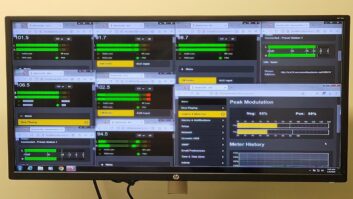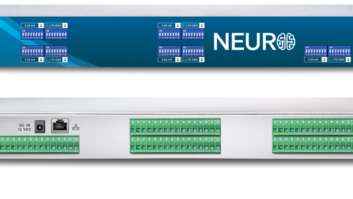
The search for increased productivity pushes many broadcasters towards IP technology. Considered less expensive than broadcast-specific baseband, one of its main attractions is its ability to handle any video and audio technology.
In many cases though, broadcasters initially opt for a “like-for-like” network replacement. This misses the key point that IP brings with it the so-called “IP LAN/WAN convergence,” which makes it easier to achieve savings and increased flexibility by sharing equipment, studios, control rooms and production staff across locations.
Many broadcasters misguidedly turn to poorly-informed IP switch vendors for advice, when they need an approach that accommodates the specific needs of broadcasting. For that reason, the initial focus should be on getting the network architecture and the control right, which means considering the three main architecture layouts that are typically used.
CENTRALIZED STAR NETWORK
In architecture terms, the tendency for most broadcasters is to adopt what is known as a “centralized star network” with all connections transiting through a large IP router that can be located in the master control room.
The main disadvantage is that everything needs to travel to the central router, requiring expensive fiber connections with every single device.
[Read: IP Is Changing The Future Of The Broadcast Control Room]
Scalability is another problem. Capacity is often reached sooner than anticipated, necessitating replacement of the central router. Since every connected device occupies one expensive high-bandwidth port on the central router, the cost-per-port for low bandwidth devices is high.
Moreover, lack of aggregation means redundancy needs to be handled by edge devices, necessitating two connections to the central router, or one to each of the main and backup switches. Finally, the assumption that all traffic will transit through the central router makes star network architecture unsuitable for treating remote locations as extensions of the main location.
SPINE LEAF
The second model is “spine-leaf architecture,” involving two or more routers at the core (spine) and other smaller routers at the edge (leaf).
This reduces the number of connections going directly to the main routers, leading to simplified fiber management. It requires fewer ports on the central router(s), and delivers more effective cost-per-port, especially for low-bandwidth devices.
Spine-leaf architecture reduces the cost of building-in redundancy and also provides optimal flexibility and scalability. Networks no longer have to be oversized from the outset, since capacity can be added over time.
While true spine-leaf architecture can be more complex than other approaches, it is a scalable, resilient and high-performance structure perfectly suited to the needs of broadcasters.
DUAL STAR
This third architecture model is “dual star” architecture which still involves the use of two spine routers, but with the difference that each leaf in the network is only connected to one spine.
Unfortunately, this is not a flexible approach when it comes to load distribution and optimization of total network capacity. As a “pseudo” spine-leaf approach, it puts special requirements on end devices that need redundant connections when the network evolves and it also suffers from redundancy problems.
The proponents of this architecture usually favor automatic protocol-based routing rather than software-defined networking. Yet, despite being better suited to automated routing, the dual star is not a preferable option overall. Only a true spine-leaf architecture enables broadcasters to get the most out of their IP infrastructure investment in their facilities.
However, as well as network architecture, broadcasters also need to orchestrate and control the IP media network, weighing up the comparative advantages of automatic routing and SDN.
AUTOMATIC ROUTING
Automatic routing means leaving the decision about how to transport individual media flows to the network, rather than the operator.
While automatic routing — and the IGMP and PIM protocols — are used widely in IP networks across the world, they have disadvantages in terms of performance and bandwidth management.
Automatic routing may not be fast enough for live production and can run into trouble with network loops. This can only be fixed through higher operational complexity — and unless care is taken in designing and controlling the network there is a risk of oversubscribing it, causing instability and signal drop-outs. On top of this, there are also concerns around protection and security, as streams to destinations are not explicitly controlled.
SOFTWARE-DEFINED NETWORK ROUTING
SDN puts routing control in the hands of a centralized control layer. The management and orchestration software holds a complete view of the available equipment, the network infrastructure and the services. This enables it to make intelligent decisions on routing and controlling flows and provides the explicit routing capability that broadcasters expect and need.
This has many advantages. Firstly, it guarantees a higher level of performance when compared with automatic routing, since the software is also in control of every media flow. It is even beneficial from a protection and security perspective as the orchestration and control software can easily create path diversity to protect failures and can also reduce security risks by fully controlling which destination is allowed to receive which multicast.
Unlike automated routing, SDN can, with the right software, easily handle any network architecture. Ultimately, all its advantages make it the control of choice for the creation of truly flexible, scalable and high-performance IP media networks.
Despite the obvious benefits of IP technology, broadcasters should bear in mind that a successful IP infrastructure is built around the “ground-up design” of infrastructure. Success is also largely determined by the way in which individual elements within the network are controlled.
Broadcasters should be architecting a network using a true spine-leaf model, and controlling the elements within it using SDN routing. It is the most effective way of maximizing IP technology, in turn helping deliver optimal return on investment and higher chances of operational success.
Olivier Suard is vice president of marketing for Nevion.












